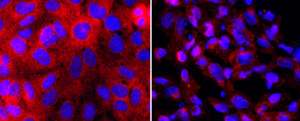Kidney cells made from reprogrammed stem cells lead scientists to an accurate way to screen for toxic compounds

A platform that could help pharmaceutical, chemical and food companies screen for safe compounds for kidneys has been set up by A*STAR scientists, who have created the fastest and most efficient protocol for coaxing stem cells to become kidney proximal tubular cells (PTCs).
Daniele Zink from the A*STAR Institute of Bioengineering and Nanotechnology (IBN) and colleagues have, for the past several years, sought to transform human stem cells into PTCs. These cells come from the functional unit of the kidney known as the nephron, and they are particularly vulnerable to toxicity because of their roles in compound transport, metabolism and clearance.
Damage to PTCs can lead to major health problems such as acute kidney injury or chronic kidney disease. Therefore a system that can predict kidney toxicity in the laboratory before experimental medicines, cosmetics or chemicals ever reach human patients is a valuable research tool.
"This new screening platform would reduce costs for industry and help to develop safer compounds," says Zink.
In collaboration with IBN executive director Jackie Y. Ying, Zink's team first successfully made PTCs with embryonic stem cells. In parallel, Zink's team developed the first predictive renal in vitro screening platform. Combining the technologies resulted in the first stem cell-based screening platform for kidney toxicity. But the differentiation process was inefficient. So, the researchers turned to induced pluripotent stem cells (iPSCs), formed by reprogramming adult cells to an embryonic-like state, and developed a one-step protocol for turning these stem cells into the desired kidney cells in just eight days. The proximal tubular cells were more than 90 per cent pure—good enough for toxicity testing.
Zink's lab combined the iPSC-derived PTCs with their screening technology and analytic methods developed by Lit-Hsin Loo's group at the A*STAR Bioinformatics Institute. Using this screening platform, the researchers looked at 30 compounds—some known to be safe, others toxic—and found that the platform predicted kidney toxicity with high accuracy. They also studied the cellular pathways of drug-induced injury and found that the iPSC-derived kidney cells correctly recapitulated known toxicity mechanisms.
"We have developed the first animal-free renal screening platforms and the only iPSC-based model for the accurate prediction of kidney toxicity in humans," says Zink.
Zink and her team are now using the same approach to create personalized drug screening platforms. Meanwhile, they are adapting the process to be more compatible for use at an industrial scale. "We will continue working with Ying's lab on developing automated and microfluidic platforms," Zink says.
More information: Karthikeyan Kandasamy et al. Prediction of drug-induced nephrotoxicity and injury mechanisms with human induced pluripotent stem cell-derived cells and machine learning methods, Scientific Reports (2015). DOI: 10.1038/srep12337


















